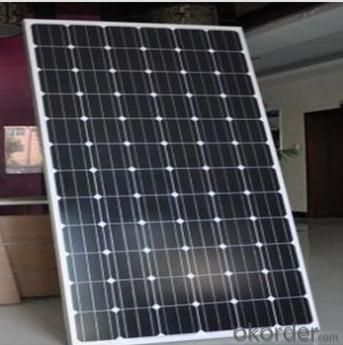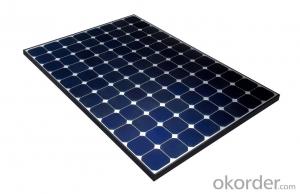CNBM Mono Solar Panel 235W A Grade with Factory Price
- Loading Port:
- Shanghai
- Payment Terms:
- TT OR LC
- Min Order Qty:
- 100 watt
- Supply Capability:
- 100000 watt/month
OKorder Service Pledge
OKorder Financial Service
You Might Also Like
Item specifice
CNBM Moly Solar Panel 235W A Grade with Factory Price
Production description
A solar panel is a collection of solar cells. Lots of small solar cells spread over a large area can work together to provide enough power to be useful
The efficiency of a module determines the area of a module given the same rated output – an 8% efficient 230 watt module will have twice the area of a 16% efficient 230 watt module.
A solar cell, or photovoltaic cell, is an electrical device that converts the energy of light directly intoelectricity by the photovoltaic effect, which is a physical and chemical phenomenon.[1] It is a form of photoelectric cell, defined as a device whose electrical characteristics, such as current, voltage, or resistance, vary when exposed to light. Solar cells are the building blocks of photovoltaic modules, otherwise known as solar panels.
however, problems such as shadow effects can shut down the weaker (less illuminated) parallel string (a number of series connected cells) causing substantial power loss and possible damage because of the reverse bias applied to the shadowed cells by their illuminated partners. Strings of series cells are usually handled independently and not connected in parallel, though (as of 2014) individual power boxes are often supplied for each module, and are connected in parallel. Although modules can be interconnected to create an array with the desired peak DC voltage and loading current capacity, using independent MPPTs (maximum power point trackers) is preferable. Otherwise, shunt diodes can reduce shadowing power loss in arrays with series/parallel connected cells.[citation needed]
Application
Aerospace
Residential
Commercial
Large solar power plant
Distributed plant
Product Feature
1.A grade high efficiency solar cells.
2.TUV/UL/CE/CEC etc
3.Fast shippment
4.25 years warranty
5.OEM
Package
24pcs into one carton, 312pcs into a 20 foot container, 728pcs into a 40 foot container.
- Q:Can solar panels be used in areas with limited sunlight?
- Yes, solar panels can still be used in areas with limited sunlight. While solar panels are most efficient in direct sunlight, they can still generate electricity even in areas with less sunlight. The panels can capture diffuse sunlight and convert it into usable energy. However, the overall energy output may be lower compared to areas with abundant sunlight. Additionally, advancements in solar technology and the use of more efficient panels can further enhance their performance in areas with limited sunlight.
- Q:What direction do solar panels usually point? North? East? South? West?
- South in the northern hemisphere. - this gives you sunlight on the panel a major portion of the day without the need for a mechanism to follow the sun or change direction from E to S to W as the day progresses
- Q:How do solar panels affect roof weight load?
- Solar panels can increase the weight load on a roof, as they require mounting brackets and additional equipment to be installed. However, modern solar panels are designed to be lightweight and are typically not heavy enough to cause any significant structural damage to the roof. It is important to consult with a professional to assess the roof's load-bearing capacity before installing solar panels.
- Q:what is the average cost, for a single family home, to install solar panels? I live in CA.
- Although its costs have been going down a little, solar power is still pretty expensive. To power a home you are looking at at between $8000 to $20,000 dollars (it will eventually pay for itself). There are systems that tie into the existing local power supply so that you have the city's power for back up (note: most power companies will buy electricty from you if you make more than you use). Then, of course, there are stand alone systems that operate without anyother power source (these are best for use in a place where electric lines aren't available or practical).
- Q:How are solar panels installed?
- Solar panels are typically installed on rooftops or open spaces using metal frames or mounting brackets. The process involves anchoring the panels securely, connecting them in a series or parallel configuration, and wiring them to an inverter that converts the DC electricity generated by the panels into usable AC electricity. Additionally, a solar panel installation may require making electrical connections to the building's electrical system and installing a net meter to measure the energy produced and consumed.
- Q:Can solar panels be installed on a fire station or emergency services building?
- Yes, solar panels can be installed on a fire station or emergency services building. In fact, many fire stations and emergency services buildings have embraced solar energy as a sustainable and cost-effective solution. Solar panels can help these facilities generate their own electricity, reduce utility bills, and lower their carbon footprint. Additionally, the availability of rooftop space on such buildings often makes them suitable for solar panel installation.
- Q:My house is aligned exactly North-South, so I have no roof facing South. Is it worth installing solar panels? Are there any good options for dealing with this situation?
- Several options: The panels could be mounted on the ground. We mount panels on a roof because they are out of the way but it is not the best choice. The highest output (and most expensive) choice is to mount the panels on the ground fixed in a heliostat (sun tracking mechanism) Far better if the panels are on the ground where they can be more easily cleaned to promote top efficiency. If you have the room they can be mounted in an angled array. Panels can be mounted on the side of a house or on the roof using racks to position the panels properly. We usually say that if we can get the panels within 5 degrees of due south it is sufficient. You could even mount the panels flat onto the side of a house and use mirror mounted heliostats to reflect sunlight to them. All of these options will be more expensive than a perfectly oriented home. There are also other alternatives for producing electricity, conserving electricity through energy savings, or production of other forms of energy that offsets electrical usage. A site survey is the best way to determine this.
- Q:Can solar panels power an entire house?
- Yes, solar panels can power an entire house. The number of panels required depends on the energy needs of the house, the location, and the efficiency of the panels. However, with the right setup and sufficient sunlight, solar panels can generate enough electricity to meet the power demands of a household.
- Q:Can solar panels work during cloudy or rainy days?
- Yes, solar panels can still work during cloudy or rainy days, but their efficiency is significantly reduced. Solar panels generate electricity by converting sunlight into usable energy, so the amount of energy produced is directly related to the amount of sunlight available. Cloudy or rainy weather reduces the intensity of sunlight reaching the panels, resulting in a lower electricity output. However, solar panels can still generate some power even in these conditions, making them a viable source of renewable energy even on less sunny days.
1. Manufacturer Overview |
|
|---|---|
| Location | |
| Year Established | |
| Annual Output Value | |
| Main Markets | |
| Company Certifications | |
2. Manufacturer Certificates |
|
|---|---|
| a) Certification Name | |
| Range | |
| Reference | |
| Validity Period | |
3. Manufacturer Capability |
|
|---|---|
| a)Trade Capacity | |
| Nearest Port | |
| Export Percentage | |
| No.of Employees in Trade Department | |
| Language Spoken: | |
| b)Factory Information | |
| Factory Size: | |
| No. of Production Lines | |
| Contract Manufacturing | |
| Product Price Range | |
Send your message to us
CNBM Mono Solar Panel 235W A Grade with Factory Price
- Loading Port:
- Shanghai
- Payment Terms:
- TT OR LC
- Min Order Qty:
- 100 watt
- Supply Capability:
- 100000 watt/month
OKorder Service Pledge
OKorder Financial Service
Similar products
New products
Hot products
Hot Searches
Related keywords



























